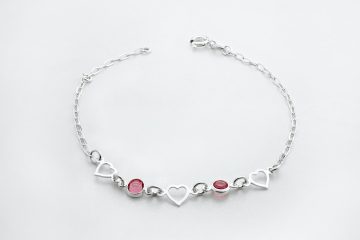Are you interested in making your own beaded bracelets? Creating your own jewelry is not only a fun and rewarding hobby but also a way to express your personal style. Whether you’re a beginner or have some experience in jewelry making, this step-by-step guide will walk you through the process of creating beautiful beaded bracelets. From selecting the right materials to mastering different techniques, let’s dive into the world of beaded bracelet making!
1. Introduction to Beaded Bracelet Making
Beaded bracelet making is a fascinating craft that allows you to combine various beads, colors, and patterns to create unique pieces of jewelry. It offers endless possibilities for customization and personalization. The first step in your beading journey is to gather the necessary materials.
2. Materials Needed for Beaded Bracelet Making
To get started, you’ll need a few essential materials:
– Beads: There is a wide variety of beads available, including glass, plastic, wooden, and gemstone beads. Choose beads that suit your personal taste and the design you have in mind.
– Stringing Material: There are several options for stringing material, such as stretchy cord, nylon thread, or beading wire. The choice depends on the type of bracelet you want to make and the strength required.
– Clasps and Findings: These are used to secure the bracelet and make it easy to put on and take off. Lobster clasps, toggle clasps, and magnetic clasps are common options.
– Tools: Basic tools like scissors, crimping pliers, wire cutters, and bead mats will come in handy during the bracelet-making process.
– Findings: Jump rings, crimp beads, and spacers are essential for adding finishing touches and creating a professional look.
3. Choosing the Right Beads
When it comes to choosing beads for your bracelet, the possibilities are endless. Consider the following factors:
– Size: Beads come in various sizes, from tiny seed beads to larger focal beads. Think about the overall look and feel you want to achieve and select beads accordingly.
– Material: Beads can be made from glass, plastic, wood, gemstones, or even metal. Each material has its own unique characteristics and visual appeal.
– Color: The color scheme of your bracelet can be inspired by your favorite colors, a specific theme, or the symbolism associated with different colors. Experiment with different color combinations to find what resonates with you.
– Shape and Texture: Beads come in an array of shapes, such as round, oval, cylindrical, or faceted. Consider the texture and how it complements the overall design.
4. Preparing the Beads and Stringing Material
Before you start stringing your beads, it’s essential to prepare them and the stringing material:
– Sort and Organize Beads: Take time to sort your beads by size, color, or any other criteria that will help you easily find the beads you need during the bracelet-making process. Use small containers or bead organizers to keep them organized.
– Measure the Stringing Material: Determine the desired length of your bracelet and add a few extra inches for ease of stringing and adjusting the size later on. Cut the stringing material to the appropriate length.
– Secure the Ends: To prevent beads from sliding off the stringing material, you can tie a knot at one end or use a bead stopper. This will keep your beads in place as you work.
5. Stringing Techniques
There are various techniques you can use to string your beads. Here are a few popular methods:
– Simple Stringing: This technique involves threading the beads onto the stringing material and securing the ends with clasps. It’s a straightforward method suitable for beginners.
– Knotting: Knotting between each bead adds a professional touch to your bracelet and prevents beads from rubbing against each other. This technique is commonly used for pearl bracelets.
– Wire Wrapping: If you want to add a more intricate design element, consider wire wrapping beads or charms onto the bracelet. This technique requires some practice and specialized tools.
– Macrame: Macrame involves using knots to create patterns and designs with the stringing material itself. It’s a versatile technique that adds texture and visual interest to your bracelet.
6. Designing Your Beaded Bracelet
Now comes the creative part – designing your beaded bracelet. Here are some tips to help you unleash your creativity:
– Plan Your Design: Before you start stringing the beads, sketch out your design on paper or use a jewelry design software. This will help you visualize the final result and make any necessary adjustments.
– Experiment with Patterns: Beads can be arranged in various patterns, including symmetrical, random, or repeating patterns. Play around with different arrangements until you find a design that appeals to you.
– Add Charms or Pendants: Charms and pendants can add a personal touch to your bracelet. Consider adding birthstone charms, initials, or meaningful symbols that reflect your personality or commemorate a special event.
– Incorporate Spacers and Accent Beads: Spacers and accent beads can be used to break up patterns, add contrast, or create focal points in your bracelet. They can enhance the overall design and make it more visually appealing.
7. Finishing Touches and Clasps
Once you have completed stringing your beads, it’s time to add the finishing touches and secure your bracelet with a clasp:
– Add Spacers or Bead Caps: To create a more polished look, you can add spacers or bead caps at the ends of your bracelet. These will give your bracelet a more professional finish.
– Attach the Clasp: Depending on the type of clasp you have chosen, you may need to use jump rings or crimp beads to attach it securely to the ends of your bracelet. Ensure that the clasp is easy to open and close.
– Test the Fit: Before finalizing your bracelet, try it on to ensure the size is comfortable. If necessary, adjust the length by adding or removing beads. Remember to account for the size of the clasp when measuring.
8. Caring for Your Beaded Bracelet
To ensure that your beaded bracelet remains in good condition and lasts for a long time, it’s important to take proper care of it:
– Avoid Water and Chemicals: Water, perfume, and harsh chemicals can damage the beads and the stringing material. Remove your bracelet before bathing, swimming, or applying lotions or perfumes.
– Store Properly: Keep your bracelet in a dry, cool place, away from direct sunlight. Store it in a jewelry box or a pouch to prevent tangling and protect it from dust and scratches.
– Clean Regularly: Use a soft cloth to gently clean your bracelet and remove any dirt or oils that may have accumulated. Avoid using harsh cleaning agents or abrasive materials that could scratch the beads.
Conclusion
Creating your own beaded bracelets is a fantastic way to express your creativity and showcase your personal style. With this step-by-step guide, you now have the knowledge and skills to embark on your beading journey. Remember to have fun, experiment with different techniques and designs, and let your imagination run wild. Happy bracelet making!
FAQs
1.
Can I use any type of beads for making bracelets?
Yes, you can use various types of beads such as glass, plastic, wood, or gemstone beads. Choose beads that suit your taste and design.
2.
What is the best stringing material for bracelets?
The best stringing material depends on the type of bracelet you want to make. Stretchy cord is great for easy-to-wear bracelets, while nylon thread or beading wire is suitable for more structured designs.
3.
How do I determine the right size for my bracelet?
Measure your wrist using a flexible measuring tape and add a few extra inches for a comfortable fit. Alternatively, you can use an existing bracelet as a reference.
4.
Can I add charms or pendants to my beaded bracelet?
Yes, adding charms or pendants is a great way to personalize your bracelet. Choose symbols or designs that hold personal meaning to you.
5.
How do I clean my beaded bracelet?
Use a soft cloth to gently clean your bracelet and remove any dirt or oils. Avoid using harsh cleaning agents or abrasive materials that could damage the beads.




